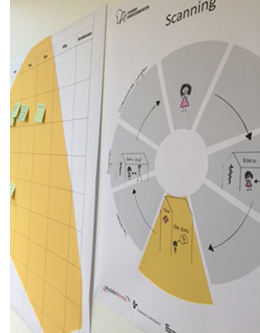Background
Osteoporosis is one of eight chronic diseases and disorders registered in Denmark. The disease is characterised by low bone mass to such an extent that the tensile strength of bone is reduced, which may subsequently increase the risk of incurring fractures. The diagnosis is made by use of a DXA scan that checks the bone mineral density of the patient. An estimated 550,000 Danes have osteoporosis. The incidence is increasing, and therefore efforts are targeted at tracking down the disease and prevent fractures. Especially women, after their menopause, are diagnosed with the disease, before it causes symptoms of fracture. This leaves women in the grey area between sick and healthy, and a health-care option is required to support these women in managing the elucidation process, the decisions about types of treatment, and the time intervals between scans.
Mobile health technologies have already proven to be an effective tool to support communication and cooperation between citizens, patients and health professionals. Since there is currently no such offer to women with osteoporosis, this project will design, develop and test a mobile health technology option for women aged 50-65 years who are diagnosed with osteoporosis. The process takes place in close cooperation with these women, doctors, health professionals and experts from the Osteoporosis Clinic at Odense University Hospital, the Danish Osteoporosis Society and the company Mobile Fitness.
Purpose
 The aim of the project is to investigate whether mobile health technologies can be a useful option for women who are diagnosed with osteoporosis. The focus of the investigation is to increase women's sense of involvement in the elucidation process so that they feel equipped to make decisions about their medical treatment, and be able to exercise self-care and empowerment in the subsequent period when it is recommended that they take additional doses of calcium and vitamin D and live "bone friendly". Many feel that it is a jungle to find one's way around, and since there is no clear answer to how each woman should handle her diagnosis, the vision is to design and develop a mobile health technology that can support each woman in managing her own diagnosis and making the decisions that are necessary, in consultation with the healthcare professionals.
The aim of the project is to investigate whether mobile health technologies can be a useful option for women who are diagnosed with osteoporosis. The focus of the investigation is to increase women's sense of involvement in the elucidation process so that they feel equipped to make decisions about their medical treatment, and be able to exercise self-care and empowerment in the subsequent period when it is recommended that they take additional doses of calcium and vitamin D and live "bone friendly". Many feel that it is a jungle to find one's way around, and since there is no clear answer to how each woman should handle her diagnosis, the vision is to design and develop a mobile health technology that can support each woman in managing her own diagnosis and making the decisions that are necessary, in consultation with the healthcare professionals.
The project is divided into three phases: the first phase uncovers the needs of the women involved through qualitative interviews, observations, and literature about the subject. In addition, interviews are conducted with general practitioners (GPs), experts in the field of osteoporosis, health professionals working with the target group, and the Danish Osteoporosis Society. The needs identified will form thebasis of the second phase of the project during which designs and different solutions will be developed to meet the needs required. In the third phase the technology developed will be tested in a pilot phase. Finally, the technology developed will be adjusted based on the results of the pilot phase, and subsequently be prepared for implementation in the "My Story" at OUH.
Expected Results
The project will support the ongoing development within the healthcare system, where the "healthy sick" are requested to take care of themselves, and not visit the GP's clinic or the hospital as often as before. The future vision is that mobile health technologies can improve patients' self-care ability as well as reduce the pressure on the healthcare system. The project will examine whether this is possible within the field of osteoporosis. It is expected that the emerging technologies can be used, inter alia, to submit the scanning results to the patient immediately after the scan. In addition, the technology may provide important information on different treatment options, so that the patient can be well prepared for a subsequent meeting with her physician and thus involved in the decisions to be taken about the types of treatment available.